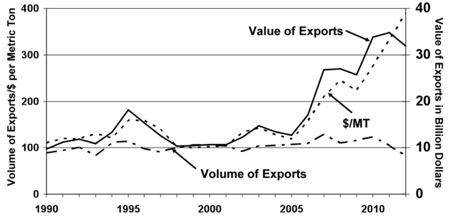|
Price And The Value Of Agricultural Exports

Exports are a big deal for agriculture, always have been and always will be. Of course, the mix of agricultural exports has changed over time. Tobacco exports back to the mother country have been replaced with worldwide exports of grains, oilseeds, livestock products, and a host of other foods, some sent raw or in bulk, others highly processed.
Recent years have been particularly good for agricultural exports. Agricultural exports set a new record of $140.9 billion in Fiscal Year 2013. Agriculture Secretary Tom Vilsack commented, “The period 2009-2013 stands as the strongest five-year period for agricultural exports in our nation’s history.”
Last fall he encouraged Congress to pass a farm bill, partly as a means to keep up the “incredible momentum” of agriculture exports by continuing to fund trade promotions programs. The Agriculture Act of 2014 came through with funding for the Market Access Program. The 2014 Farm Bill also creates an undersecretary of agriculture for trade and foreign agriculture. Clearly, Congress and the Obama administration are fans of agricultural exports and are planning for continued growth in the value of agricultural exports
The question is: Will the value of agricultural exports during the time of the 2014 Farm Bill experience the remarkable growth that was chalked up during the tenure of the 2008 Farm Bill?
Let’s begin by asking a different question: besides the ethanol phenomenon, what is the most striking thing that happened to crop agriculture in previous 5 years? Yep, crop prices rose to levels that few thought were even remotely possible.
Next question: Were those mammoth crop price increases largely responsible for growth the value agricultural exports? In the case of grains (primarily corn and wheat) and soybeans, the answer is definitely yes.
Figure 1 shows the volume of corn, soybeans, and wheat exports to be somewhat variable but relatively flat (line with long and short dashes). On the other hand, the value of exports (solid line) has exploded since the mid-2000s as has the price per metric ton (dotted line). The price and value of exports move together with few exceptions.

Figure 1: Corn, soybeans, and wheat – Volume of exports in thousand metric tons, value of exports in billion dollars, and price per metric ton in dollars.
Corn and soybeans are the top two contributors to the total value of agricultural exports. Cl-early, their export values in the years ahead will be highly influenced by their prices.
As column readers are aware, history tells us that multi-year periods of exceptionally high crop prices are usually followed by much longer periods of exceptionally low crop prices. If that is the case, Secretaries of Agriculture in future years may be explaining dramatic drops in the value of agricultural exports.
Of course, the similarity of trends in export values and prices for other categories of agricultural exports – especially the growing volume of highly processed exports – are not universally as strong as the trends in crop export value and crop price.
Still, it seems most likely that over the period of the next farm bill, the overall trend in the value of agricultural exports will point in the same direction as the overall trend in crop prices.∆
DR. DARYLL E. RAY: Blasingame Chair of Excellence in Agricultural Policy, Institute of Agriculture, University of Tennessee
DR. HARWOOD D. SCHAFFER: Research Assistant Professor at APAC, University of Tennessee
|
|